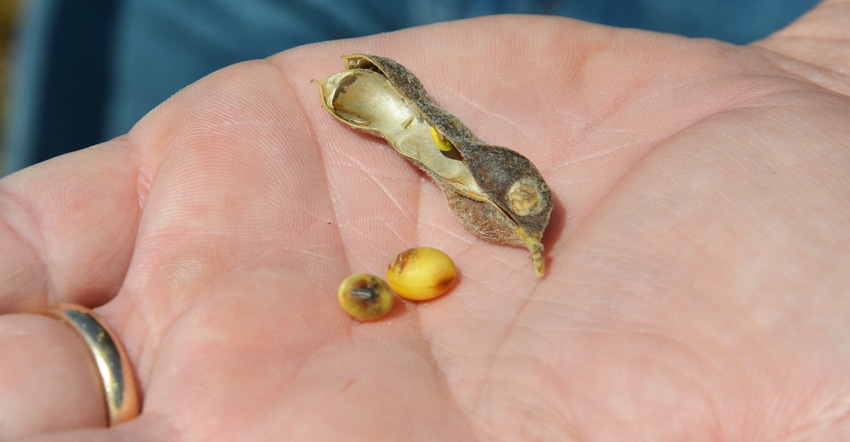
Pod and stem blight may not have affected soybean yield much in 2018, but if tests from the Illinois Crop Improvement Association are any indication, it certainly could affect seed quality.
Known scientifically as phomopsis, the blight has turned up in selected seed samples at rates as high as 86%, says Steve Beals, ICIA seed technologist and seed lab director. “Treating soybeans for phomopsis is going to be a must for selected seed lots this season,” Beals says, adding that he doesn’t recommend trying to rescue a seed lot with an infection rate of 20% of more.
“Once the seed coat has been penetrated, the fungus can continue to grow into the seed, invading and breaking down the embryo and endosperm,” he adds. Breakdown of those tissues affects quality, even when the fungus dies back under dry storage conditions. That damage affects both viability and vigor.
“There are simply too many variables to move away from our recommendation that you make decisions on a lot-by-lot and treatment-by-treatment basis,” Beals recommends.
ICIA found the following germ rates, as of late January:
• Central: 90.3
• East: 83.6
• East-southwest: 84.7
• Northeast: 92.8
• Northwest: 74.1
• Southeast: 76.4
• Southwest: 82.6
• West: 86.5
• West-southwest: 78.0
• Out of state: 83.8
In his interview with Prairie Farmer, Beals offers a closer look at the Illinois soybean seed germination situation for 2019.
What are you testing seed for? How much do you test each year? We test seed for quality factors such as viability, vigor and seed purity. We test thousands of soybean seed samples each year.
What germination scores are you seeing so far, and how have they changed the past couple of months? We are seeing quite a bit of variability. Scores range from zero to 99%. The average is currently at 83.8%.
How does that compare with past years, overall? This year we are seeing lower germinations than last year.
Why are they lower this year? This year we are seeing fungal issues associated with the timing of harvest and the wet weather. Scores vary from field to field and from lot to lot, depending on harvest conditions.
Is it a regional problem in Illinois? In the Midwest, Illinois is not alone in this issue, and we are seeing harvest issues affecting many of the soybean seed-producing areas of the country.
Can fungicide improve germination scores? Yes and no. Fungicides can improve the performance of seed with seedborne fungi, but it does not cure mechanical damage and severe infections that penetrate the embryo and endosperm. Sometimes fungicide takes care of one problem only to reveal another like mechanical damage. Physical damage to an essential structure of the embryo or seed is called mechanical damage.
What do farmers need to do this spring? As always, purchase seed from a reputable seed company. Farmers need to know that they are receiving the best seed available. Lower-than-normal germs may require an adjustment to planting rates. Farmers should work closely with their seed company and suppliers, as returning a seed lot may mean they have rejected the best they can get.
What’s your take on treated seed? It is impossible to make a blanket statement or recommendation due to the harvest issues. Proper testing provides the information necessary to make decisions on a lot-by-lot and treatment-by-treatment basis. Seed treatment can help but provides protection in the field, and treated seed should not be considered inferior by any means.
Questions or concerns about different treatment options? Contact Beals at [email protected], or call 217-359-4053. You can also download the Crop Protection Network’s soybean seed treatment guide.
About the Author(s)
You May Also Like






